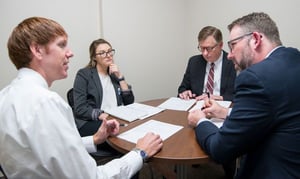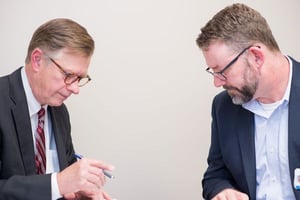 What are the attributes of a core lab?
What are the attributes of a core lab?
The concept of core lab utilization has become an integral part of clinical trial design and management during the past couple of decades. A core lab’s primary purpose is to eliminate variability in reporting and to provide independent and accurate data analysis that conforms to the latest standards and guidelines. Core labs function as independent adjudicating centers that have quality assurance systems in place to eliminate both inter-observer and intra-observer variability. The “clean” data can then be submitted to the sponsor and government regulatory agencies such as the U.S. Food and Drug Administration and for European Union CE mark.
The core lab also functions as an unbiased and trusted member of the clinical trial management team by providing independent, ongoing input to the lead investigators, the sponsor, data safety monitoring committee and the regulatory agencies. Most well-designed cardiovascular trials now include (and most sponsors require) core lab adjudication as a requirement.
The need for additional core labs
When taken in the long view, clinical understanding of venous disease management is in a relatively nascent stage when compared to the arterial system. There are more “unknowns” than “knowns,” as experts in the field forge ahead to find appropriate treatments for venous disease. A recent example is the ATTRACT trial. This landmark study was designed and conducted by the world’s leading experts in venous disease. During this 10-year study, practice patterns changed and trial management standards became more stringent. Lack of core lab adjudication for venography and intravascular ultrasound has been perceived as a shortcoming of this trial by some experts.
The concept of establishing a core lab at OhioHealth began because of a lack of perceived venous expertise in core lab space. Over the last few years, OhioHealth Vascular Services has been approached by several sponsors and key opinion leaders asking if we would consider providing core lab services for their venous disease clinical trials. Although our expertise spans both arterial and venous disease imaging, the apparent unmet need led us to examine current clinical and business models, and to establish a nonprofit core lab, associated with OhioHealth’s Research and Innovation Institute (OHRI). The nonprofit status provides credibility by eliminating any financial conflict of interest, and reinforces the core lab’s primary mission to improve the quality of clinical research.
The core lab’s credibility is further reinforced by anchoring it with a large and respected healthcare system such as OhioHealth. As with any large organization, the first step in creating a new business venture is to assess the organization’s interest in the business concept. OhioHealth recognized the value in the concept, and leadership approved support for the new business unit. One reason leadership embraced the core lab concept was because OhioHealth already has staff with great national collaborative relationships.
The uniqueness
 There are several core labs currently operating in the field of cardiovascular medicine but few, if any, fill the niche area of vascular disease imaging. In an effort to be unique within this space, the decision was made to offer adjudication services for the most important and commonly tested vascular imaging modalities and vascular wound imaging, along with onsite, trial-specific sonographer training all under one roof.
There are several core labs currently operating in the field of cardiovascular medicine but few, if any, fill the niche area of vascular disease imaging. In an effort to be unique within this space, the decision was made to offer adjudication services for the most important and commonly tested vascular imaging modalities and vascular wound imaging, along with onsite, trial-specific sonographer training all under one roof.
OhioHealth’s core lab is able to adjudicate various imaging modalities including extravascular and intravascular ultrasonography, venography and arteriography. The vascular anatomy covered includes carotid arteries, aorta, renal arteries, iliac arteries, femoro-popliteal arteries, infrapopliteal arteries, pulmonary arteries and superficial and deep venous systems. Bundling of services not only improves workflow for the sponsor, as it eliminates the need to coordinate work flow with multiple core labs, but also lowers trial-related costs.
Hands-on ultrasonography training tailored to the specific trial protocols is also a significant unmet need. Providing such training during or prior to trial initiation results in improved quality and consistent image acquisition at all participating sites. Training courses held on the OhioHealth campus allows sonographers to get hands-on training on live volunteer patients. Such training also minimizes protocol deviations related to image acquisition, and in turn result in reduced sponsor expenses.
Putting the pieces together
Setting up the core lab was quite challenging; months of planning for personnel, finding the appropriate business director, figuring out the financial requirements and conducting market research to determine customer and market needs. Physical office space; HIPAA compliant, user-friendly, cloud based imaging transfer technologies, a training center and related information systems infrastructure support are mandatory requirements for day-to-day operations.
Once these are in place, preparing for regulatory agencies and sponsor audit is the next major challenge the core lab faces. The build-out phase is currently a work in progress, and marketing a “soft-launch” of the core lab was initiated at the VIVA 2017 conference in Las Vegas. Even with this limited exposure, requests for help are coming in, which is extremely encouraging and rewarding.
 The core lab will operate as a service of the OHRI, which focuses on research involving new drugs, medical devices and procedures. The institute is ranked in the top 10 percent of programs among similar nonprofit, community-based healthcare systems focusing on industry, academic, innovation and commercialization research. It gives patients access to clinical trials, helps staff develop new healthcare products, supports medical education and other scholarly research, and implements programs to assess and address health disparities in our local communities. OHRI’s leadership is led to believe that there is a need for a Midwest core lab and that there’s an industry void. Having a core lab raises OhioHealth’s profile and overall image, and also provides the health system with early insight into trials that it might not have had access to—this is good for OhioHealth patients.
The core lab will operate as a service of the OHRI, which focuses on research involving new drugs, medical devices and procedures. The institute is ranked in the top 10 percent of programs among similar nonprofit, community-based healthcare systems focusing on industry, academic, innovation and commercialization research. It gives patients access to clinical trials, helps staff develop new healthcare products, supports medical education and other scholarly research, and implements programs to assess and address health disparities in our local communities. OHRI’s leadership is led to believe that there is a need for a Midwest core lab and that there’s an industry void. Having a core lab raises OhioHealth’s profile and overall image, and also provides the health system with early insight into trials that it might not have had access to—this is good for OhioHealth patients.
The core lab staff
One of the most critical aspects in this endeavor was assembling an enthusiastic team that would be dedicated to the primary mission of the core lab. Many highly experienced staff at OhioHealth were attracted to and joined this new venture. The team includes a technical director, marketing manager, finance manager, regulatory officer, information systems liaison, and senior director of innovation.
The core lab also has highly experienced and skilled physician-readers who are experts in the vascular field, interpreting the imaging studies. As the director of the core lab, I feel both fortunate and honored to belong to this phenomenal team. I have the ultimate responsibility of overseeing the protocols and procedures along with business development.
The future
Other core labs will attempt to enter this space, but the multiple pieces that need to fall into place to create something like this will be rate limiting. One needs to have control over these moving pieces, along with the backing of a large corporation to run as a not-for-profit entity. While it is a difficult process to establish, the core lab concept will continue to gain traction. A core lab can start as a small operation, but with high-quality work it can be scaled to a larger entity.
In addition, the core labs will be acknowledged in the summary of study findings when they are published. The U.S. Food and Drug Administration, which is involved in most of these trials, would view the addition of core lab as an added value that improves the overall quality of medical research. Ultimately, results from a good-quality clinical study will positively affect patient care, and will receive wider acceptance from experts and practicing clinicians when an unbiased, not-for-profit core lab adjudicates the key findings without any conflict of interest.
Being a part of this team and the venture has been very rewarding, as it will eventually help our patients.


